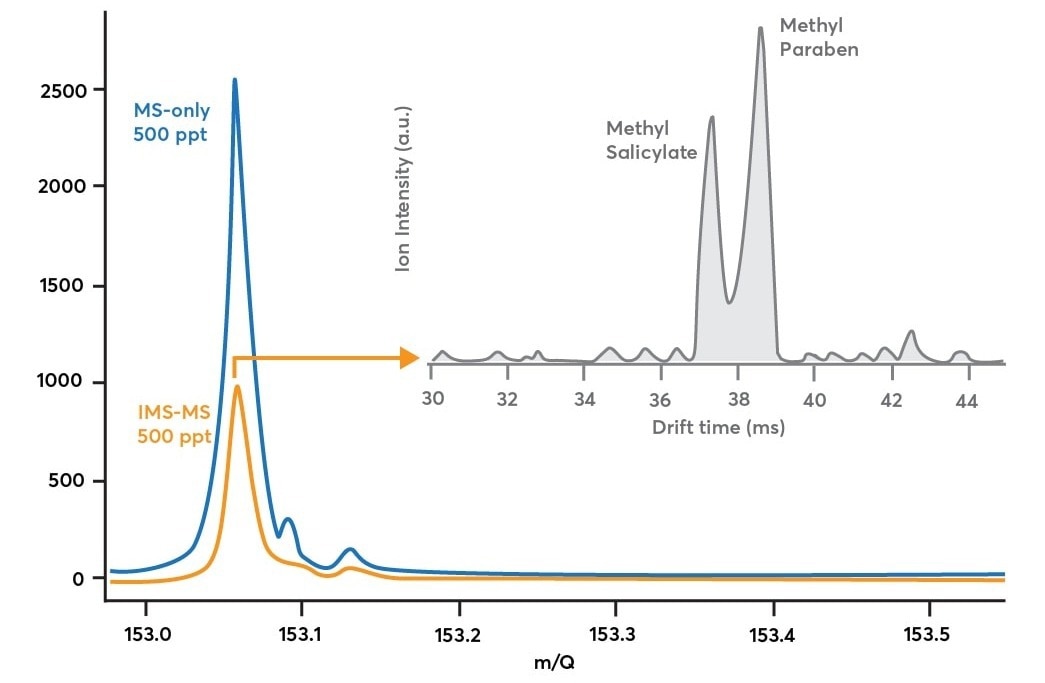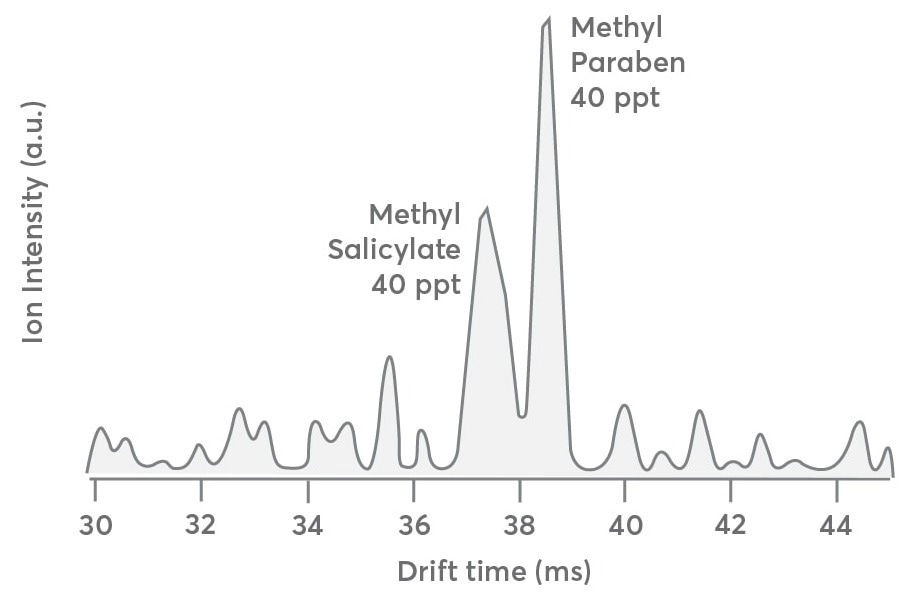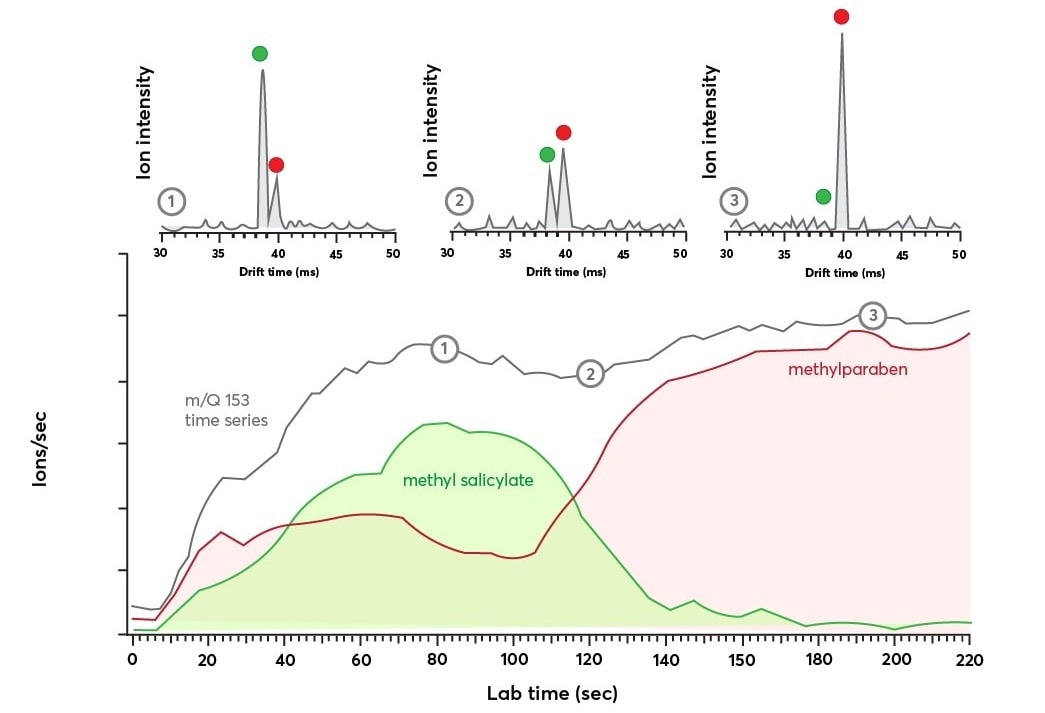Sponsored by TOFWERKReviewed by Emily MageeMar 22 2023
Chemical ionization mass spectrometers accurately evaluate VOCs in a wide range of environments. The analysis becomes ambiguous when a compound is obscured by either isomeric or isobaric interference. Because there is no definitive measurement of the structures contributing to a mass spectrum peak, interferences create uncertainty in peak identification.
This is a common problem in flavor and fragrance chemistry, where a single molecular formula (ion) may exist in multiple isomeric forms. Each ion is significant because it uniquely contributes to the perceived flavor or fragrance. Figure 1 depicts two isomers of vanillin: methyl salicylate and methyl paraben. Another dimension of separation should accompany mass spectrometry to isolate and differentiate between these isomers.

Figure 1. The isomeric structures of methyl salicylate and methylparaben. Image Credit: TOFWERK
Ion mobility spectrometry (IMS) is a method that can be used in tandem with mass spectrometry to resolve distinct isomers. IMS distinguishes between ions with structures that vary in rotationally averaged collision cross sections (i.e. average molecular size).
Analytes are ionized by chemical ionization in Vocus IMS-MS, and collision cross sections isolate the resulting ions before mass analysis. The mass-to-charge ratio and cross section-related IMS are provided in two dimensions. Multiple isomeric or isobaric components present in a single mass spectrum peak are deconvoluted.
Operation of the Vocus CI-IMS-TOF
Figure 2 depicts the TOFWERK Vocus CI-IMS-TOF schematic. The Vocus ion source produces ions before being directed into the IMS separation chamber in this instrument. The chamber is purged with an inert buffer gas (e.g. nitrogen, helium, etc.) and kept at 3 mbar pressure. Utilizing technology created at Pacific Northwest National Laboratory for lossless ion manipulations (SLIM), the ions are advanced along a 9-m serpentine path.1
Weak electric fields control ion movement. Ions with small collision cross sections experience less friction in the buffer gas and reach the end of the drift region faster than ions with larger collision cross sections. The total time an ion spends traveling through the IMS drift region is alluded to as the IMS drift time and is related to a molecule's collision cross section.

Figure 2. Schematic representation of the TOFWERK Vocus-IMS-TOF instrument. Both MS-only and IMS-MS measurements are possible as indicated by the blue and orange ion paths, respectively. Image Credit: TOFWERK
The TOFWERK Vocus CI-IMS-TOF has two modes of operation. The first mode circumvents the IMS, allowing the user to accomplish only MS measurements (blue path in Figure 2). The second mode of operation uses an ion switch to direct ions through the IMS (orange path in Figure 2), generating 2D data to deconvolute contributions from multiple isomers or isobars. When IMS capabilities are required, the Vocus CI-IMS-TOF can be easily activated.
Isomer Separation with Ion Mobility
Vocus IMS separation can be illustrated by analyzing the isomers methyl salicylate and methylparaben. Because these compounds have the same monoisotopic mass and only vary in the position of the hydroxyl group on the aromatic ring, they both generate the same mass spectrum peak in proton transfer reaction (PTR) chemistry at the same corresponding protonated mass (153.05 Th).
The blue trace in Figure 3 illustrates this. This data was obtained by sampling a methyl salicylate and methylparaben air mixture in MS-only mode at 500 ppt concentrations (blue path in Figure 2, blue in Figure 3). This data confirms the presence of at least one C8H8O3 compound, but it does not specify the number of isomers that contributed to the peak. This is the only possible explanation.

Figure 3. Blue trace: mass spectrum obtained while sampling 500 ppt methyl salicylate and 500 ppt methylparaben in MS-only mode (blue path in Figure 2). Orange trace: mass spectrum obtained while sampling the same methyl salicylate / methylparaben mixture in IMS-mode (orange path in Figure 2). Gray trace: shows how the mass spectrum in orange is decomposed along the ion mobility dimension to reveal multiple components after a 90 second acquisition. Image Credit: TOFWERK
Individual elements of a single mass peak can be isolated using IMS mode activation. Once activated, ions are directed into the mobility region (orange path in Figure 2), and a pseudorandom sequence (multiplexing) is applied to the ion gate, altering the ion signal and providing critical timing information for measuring drift times. Due to ion modulation, ion losses are visible in Figure 3 when contrasting the IMS-MS mass spectrum (orange trace) to the MS-only mass spectrum (blue trace).
Depending on the gate sequence’s 50% duty cycle, the theoretical expectation is to quantify 50% of the ion signal in IMS-MS mode versus MS-only mode. Experimentally, 40% of the ion signal is evaluated in IMS-MS mode versus MS-only mode, implying that a small percentage of ions are lost in either the drift region or at the ion gate.
Nonetheless, this ion intensity trade-off allows the generation of drift time distributions for a broad range of mass-to-charge ratios. The duty cycle is increased by multiplexing to 50%, compared to <1% in non-multiplexing methods. Figure 3 shows the drift time distribution for 153.05 Th as a gray trace. This trace, averaged over 90 seconds, reveals the effective isolation of methyl salicylate from methylparaben. The existence of either species can be easily confirmed, and their relative concentrations can be tracked over time.
To comprehend how the S:N ratio of IMS data deteriorates at concentrations below 500 ppt, the same dataset provided in Figure 3 was used. Figure 4 displays the IMS drift distribution for the methyl salicylate's first carbon isotope (13C1C7H9O3+, m/Q = 154.05 Th) and methylparaben mixture.
This is important because the first carbon isotope concentration is only anticipated to be 8% of the 12C parents or 40 ppt for each compound. Apart from the lower concentration, the drift time distribution must be nearly identical to that shown in Figure 3 for the 12C parent compounds (gray trace).
The drift distribution in Figure 4 is qualitatively similar to that in Figure 3, but the S:N ratio becomes noticeably less favorable as we approach the instrument’s LOD. This means that analytes with concentrations as low as 40 ppt can be isolated and identified using the Vocus CI-IMS-MS instrument, but longer averaging times are required.

Figure 4. Drift time distribution of the first carbon isotope (13C1C7H9O3+, m/Q 154.05) of methyl salicylate and methyl paraben sampled at 40 ppt each. The spectrum is qualitatively like that presented in Figure 3 except for the lower S:N ratio. Image Credit: TOFWERK
Real-Time Monitoring of Isomer Populations
Even though the data in Figures 3 and 4 were averaged over 90 seconds, usual drift times happen on a timescale of 20–150 milliseconds. Because mobility separations happen on such short timescales, isomer populations can be monitored in real time. This is important in monitoring processes where isomer ratios vary within timescales of <60 seconds, which is difficult for fast gas chromatography (GC) instruments to handle.
Figure 5 shows the results of a real-time measurement of isomer populations experiment. A methyl salicylate solution is injected into a liquid calibration system (LCS) and the response of the equipment is documented. In this experiment, an early spike of methyl salicylate signal is anticipated, followed by decay as the methylparaben solution washes it out of the system. The maximum methylparaben concentration is 2.5 ppb near the end of the run when the methyl salicylate injection no longer dilutes it.
Figure 5’s top panel shows three IMS spectra “snapshots” acquired at different times during the experiment and averaged over 2.9 seconds. The green and red dots represent the methyl salicylate and methylparaben mass spectra peaks, respectively. The relative intensities of these features evolve over time, implying that the relative population of the two species changes as well.
Variations in isomer populations can be tracked by combining the individual IMS signals and splitting the evaluated ion current by the integrated area ratio. This technique was used to analyze the methyl salicylate and methylparaben IMS signals; the results are shown in the bottom panel of Figure 5.
The methyl salicylate signal (green) increases rapidly until it reaches a maximum of 80 seconds, after which it decreases. The methylparaben signal (red) stays low until later in the run.

Figure 5. Bottom panel: time series data for m/Q = 153 Th showing the evolution of the ion current with time (in gray). The IMS dimension reveals the transient response of the isomers methyl salicylate (in green) and methylparaben (in red). Top panel: Shows the IMS spectra recorded at three different time points during the m/Q = 153 Th time series as indicated by the numbers 1, 2, and 3. The IMS spectra were each averaged for 2.9 seconds and show a clear exchange of ion population from methyl salicylate to methylparaben. Image Credit: TOFWERK
The gray m/Q Th channel includes contributions from methyl salicylate and methylparaben time series data. The signal here rapidly increases and then stabilizes after ~70 seconds. There is no clear sign that the isomer populations alter after this point. Along the time series trace, the labels “1,” “2,” and “3” correlate to the time points where the IMS spectra in the top panel were obtained, as implied by the matching labels.
Although it might be feasible to acquire gas chromatography data, such as that shown in Figures 3 and 4, reproducing the real-time data shown in Figure 5 would be difficult. The TOFWERK Vocus CI-IMS-TOF performs isomer separations much faster than GC, making it a powerful tool for those who require fast analysis with isomer separation.
Reference
- https://www.pnnl.gov/available-technologies/structures-lossless-ion-manipulation-slim

This information has been sourced, reviewed and adapted from materials provided by TOFWERK.
For more information on this source, please visit TOFWERK.